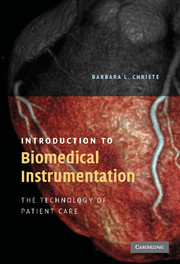Book contents
- Frontmatter
- Contents
- Preface
- INTRODUCTION TO BIOMEDICAL INSTRUMENTATION
- 1 BMET as a career
- 2 Patient safety
- 3 In the workplace
- 4 Electrodes, sensors, signals, and noise
- 5 The heart
- 6 Cardiac assist devices
- 7 Blood pressure
- 8 Respiration and respiratory therapy
- 9 The brain and its activity
- 10 The intensive care unit
- 11 The operating room
- 12 Imaging
- 13 Clinical laboratory equipment
- 14 Intravenous pumps and other pumps
- 15 Miscellaneous devices and topics
- Index
14 - Intravenous pumps and other pumps
- Frontmatter
- Contents
- Preface
- INTRODUCTION TO BIOMEDICAL INSTRUMENTATION
- 1 BMET as a career
- 2 Patient safety
- 3 In the workplace
- 4 Electrodes, sensors, signals, and noise
- 5 The heart
- 6 Cardiac assist devices
- 7 Blood pressure
- 8 Respiration and respiratory therapy
- 9 The brain and its activity
- 10 The intensive care unit
- 11 The operating room
- 12 Imaging
- 13 Clinical laboratory equipment
- 14 Intravenous pumps and other pumps
- 15 Miscellaneous devices and topics
- Index
Summary
LEARNING OBJECTIVES
1 identify and describe the function and purpose of an intravenous pump
2 identify and describe the function and purpose of a syringe pump
3 identify and describe the function and purpose of PCA devices
4 identify and describe the function and purpose of feeding pumps
Introduction
The use of technology to push fluids into a patient has evolved and expanded over time. Bottles of fluids used gravity flow to “drip” fluids into a patient. As technology expanded into health care, the bottles were replaced with plastic bags and gravity was no longer medically adequate. Electromechnical pumps are more reliable and provide constant monitoring of fluid delivery. In addition, the flexibility of some pumps has improved medication dosing and caloric delivery. Hospitals have come to depend on the use of technology to deliver fluids and medications to patients.
Infusion pumps
One of the most common pieces of equipment in the hospital, the infusion pump (also called intravenous pump, IVAC, and IV pump) delivers medication, blood, or fluid into the patient over a specific period of time at a particular rate. The name used may reflect brand names from the past, including IVAC. Many patients will be connected to several pumps delivering fluids to the patient through a vein (hence, the term “intravenous”). The pump ensures an accurate rate and, therefore, an exact dose.
- Type
- Chapter
- Information
- Introduction to Biomedical InstrumentationThe Technology of Patient Care, pp. 205 - 212Publisher: Cambridge University PressPrint publication year: 2009



